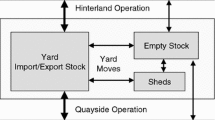Abstract
Many container terminals in the world adopt the consolidated yard planning strategy, where containers to be loaded into the same vessel are stacked in groups. This has been a good strategy because when a vessel is loading, yard cranes will be stationed at these locations, and the trucks shuttle between the quay cranes and the yard cranes almost in a conveyor belt fashion. These locations are optimally chosen such that no two groups of containers are stacked in close vicinity if they are to be loaded simultaneously. However, when there is a change in vessel arrival schedule, it may cause congestion of trucks at yard locations where groups of containers in near vicinity are loading simultaneously. While the Robust Optimisation community may suggest having a robust plan—a plan that is immune to uncertainty, in this paper, we will like to find a solution that allows us to change easily when uncertainty reveals—a plan that is nimble. While the optimum solution for the nimble plan could be intractable, we explore various heuristics that enable us to find good solutions.




Similar content being viewed by others
References
Bruzzone A, Signorile R (1998) Simulation and genetic algorithms for ship planning and shipyard layout. Simulation 71(2):74–83
de Castilho B, Daganzo CF (1993) Handling strategies for import containers at marine terminals. Transp Res B 27:151–166
Cheung RK, Li CL, Lin W (2002) Inter block crane deployment in container terminals. Transp Sci INFORMS 36(1):79–93
Du Y, Xu Y, Chen Q (2010) A feedback procedure for robust berth allocation with stochastic vessel delays. In: Proceedings of the 8th world congress on intelligent control and automation (WCICA), pp 2210–2215
Guo X, Huang SY, Hsu WJ, Low MYH (2008) Yard crane dispatching based on real time data driven simulation for container terminals. In: Proceedings of the 2008 winter simulation conference, pp 2468–2655
Guo X, Huang S, Hsu W, Low M (2009) A simulation based hybrid algorithm for yard crane dispatching in container terminals. In: Proceedings of the 2009 winter simulation conference, pp 2320–231
Han X, Lu Z, Xi L (2010) A proactive approach for simultaneous berth and quay crane scheduling problem with stochastic arrival and handling time. Eur J Oper Res 207(3):1327–1340
Hendriks M, Laumanns M, Lefeber E, Udding JT (2010) Robust cyclic berth planning of container vessels. OR Spectr 32(3):501–517
Kang J, Ryu KR, Kim KH (2006) Deriving stacking strategies for export containers with uncertain weight information. J Intell Manuf 17(4):399–410
Kim KH, Park YM, Ryu KR (2000) Deriving decision rules to locate export containers in container terminal. Eur J Oper Res 124:89–101
Kim KH, Lee KM, Hwang H (2003) Sequencing delivery and receiving operations for yard cranes in port container terminals. Int J Prod Econ 84:283–292
Kim KY, Kim KH (1997) A routing algorithm for a single transfer crane to load export containers onto a containership. Comput Ind Eng 33(3–4):673–676
Ku LP, Lee LH, Chew EP, Tan KC (2010) An optimisation framework for yard planning in a container terminal: case with automated rail-mounted gantry cranes. OR Spectr 32:519–541
Lee LH, Chew EP, Tan KC, Han Y (2006) An optimization model for storage yard management in transhipment hubs. OR Spectr 28(4):539–561
Linn RJ, Zhang CQ (2003) A heuristic for dynamic yard crane deployment in a container terminal. IEE Trans 35:161–174
Moorthy R, Teo CP (2006) Berth management in container terminal: the template design problem. OR Spectr 28(4):495–518
Murty KG, Wan YW, Liu J, Tseng MM, Leung E, Chiu HWC, Lai KK (2005) Hong Kong international terminal gains elastic capacity using a data-intensive decision support system. Interfaces 35(1):61–75
Narasimhan A, Palekar US (2002) Analysis and algorithms for the transtainer routing problem in container port operations. Transp Sci 36(1):63–78
Ng W (2005) Crane scheduling in container yards with inter-crane interference. Eur J Oper Res 164(1):64–78
Petering ME, Murty KG (2006) Simulation analysis of algorithms for container storage and yard crane scheduling at a container terminal. In: Proceedings of the second international intelligent logistics systems conference, Brisbane, Australia, pp 19.1–19.15
Saanen YA, Dekker R (2007) Intelligent stacking as way out of congested yards? part 2. Port Technol Int 32:80–85
Stahlbock R, Voß S (2008) Operations research at container terminal: a literature update. OR Spectr 30:1–52
Vis IF, de Koster R (2003) Transhipment of containers at a container terminals: an overview. Eur J Oper Res 147:1–16
Xu Y, Chen Q, Quan X (2010) A robust integrated approach to yard space allocation and crane scheduling in container terminals. In: 7th international conference on service systems and service management, pp 1–6
Zhang C, Liu J, Wan YW, Murty KG, Linn R (2003) Storage space allocation in container terminals. Transp Res B 37B:883–903
Author information
Authors and Affiliations
Corresponding author
Rights and permissions
About this article
Cite this article
Ku, L.P., Chew, E.P., Lee, L.H. et al. A novel approach to yard planning under vessel arrival uncertainty. Flex Serv Manuf J 24, 274–293 (2012). https://doi.org/10.1007/s10696-011-9124-1
Published:
Issue Date:
DOI: https://doi.org/10.1007/s10696-011-9124-1




